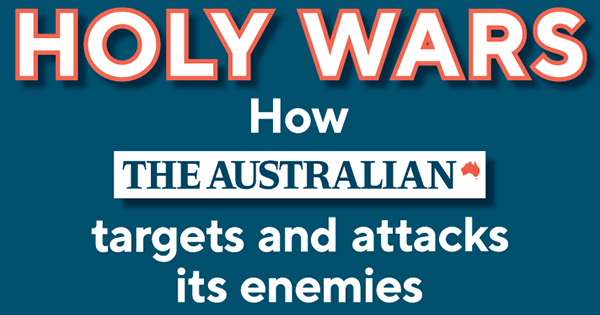
It’s a frustrating beast, The Australian. It’s got some great must-read journalism. And then there are its official dispatches from the front line of the culture wars.
Giving a name and putting a face on the enemy is central to how the paper reports the war. It gives a focus to the thousands of words thundering in an unending barrage, paragraph after paragraph. The faces say: “See! See! This is what we’re talking about!”
Sometimes the Oz‘s enemy is worth exposing. Sometimes its campaigns are a social good and we should be grateful for its contribution.
But when it comes to the culture war, the paper can seem guided more by Chuck Jones’ nine unbreakable rules of engagement for the Looney Tunes characters Wile E. Coyote and the Road Runner than by journalistic principles.
In a free society with a free media, there are, fortunately, few legal restrictions on what a paper can or cannot say. Though few, these restrictions are very real, as The Australian has recently found out: defamation, contempt of court and, even, their favourite spectre — 18C.
But the rights of the paper and of its journalists are matched with the right and the obligation to behave ethically, to act in accordance with the principles of the craft. It is this commitment to ethics by journalists that justifies the lack of legal intervention.
What does that mean? Well, for journalists at a paper like The Australian, those ethics are set out in three documents: the Journalist Code of Ethics produced by the Media, Entertainment & Arts Alliance, the Press Council Statement of General Principles and associated standards and guidelines and the company’s own Editorial Professional Conduct Policy.
The three documents have different purposes – one is about the journalists, one is about the paper and the company, and one is about the industry. But they cover similar ground. All contain lists of what you should do and what you should not do, and, in some instances, what sort of circumstances might colour an otherwise black and white divide.
Although we know The Australian needs enemies, it could stop. It could leave individuals alone.
All assert fealty to accuracy: “Take reasonable steps to ensure reports are accurate and not misleading,” instructs the News Corp policy; “Report and interpret honestly, striving for accuracy, fairness and disclosure of all essential facts,” says the MEAA Code; And, from the Press Council: “Ensure that factual material in news reports and elsewhere is accurate and not misleading.”
So far, so good. When it comes to opinion, it’s a bit more tricky. The MEAA Code doesn’t draw any distinction between news and commentary, obliging journalists to fairness in both reporting and interpreting news. The Press Council does distinguish the two and provides only that the publication should ensure that “expressions of opinion are not based on significantly inaccurate factual material or omission of key facts”.
The News Corp policy goes further, saying: “Publications are free to editorialise, campaign and take stances on issues.” This may include “comment, conjecture and opinion” provided the publication does not “knowingly publish inaccurate or misleading information”.
In other words: “Horse, cart, head this way!”
When it comes to privacy, the MEAA code says simply: “Respect private grief and personal privacy”. The News Corp policy says: “public figures necessarily sacrifice their right to privacy, where public scrutiny is in the public interest”, leaving up in the air the question of who’s a public figure and what’s the public interest.
Finally, the MEAA Code warns against placing “unnecessary emphasis on personal characteristics, including race, ethnicity, nationality, gender, age, sexual orientation, family relationships, religious belief, or physical or intellectual disability”. Neither the News Corp policy nor the Press Council Principles make any such concession.
When it acts as the Wile E. Coyote of Australian journalism, The Australian has its own protection. As Chuck Jones’ Rule 1 says: “The Road Runner cannot harm the coyote except by going ‘beep-beep’.”
In other words, while the various codes mandate a right of reply, any person who has taken that option will have learnt that their “beep-beep” is often matched by a doubling-down, with thousands more words in response to their response, often wrapped around the reply.
Like Wile E. Coyote, The Australian has access to outside help (See Rule 7: All materials, tools, weapons, or mechanical conveniences must be obtained from the Acme corporation.) In this case, for “the Acme corporation” read: the reliable quotes and contributions from commentators and the consequent piling-on through the amplification of social media.
Although we know The Australian needs enemies, it could stop. It could leave individuals alone. Except, as a number of its enemies have found, for Jones’ Rule 3: “The Coyote could stop anytime — if he were not a fanatic”.
TOMORROW: The war against Julian Disney








Crikey is committed to hosting lively discussions. Help us keep the conversation useful, interesting and welcoming. We aim to publish comments quickly in the interest of promoting robust conversation, but we’re a small team and we deploy filters to protect against legal risk. Occasionally your comment may be held up while we review, but we’re working as fast as we can to keep the conversation rolling.
The Crikey comment section is members-only content. Please subscribe to leave a comment.
The Crikey comment section is members-only content. Please login to leave a comment.